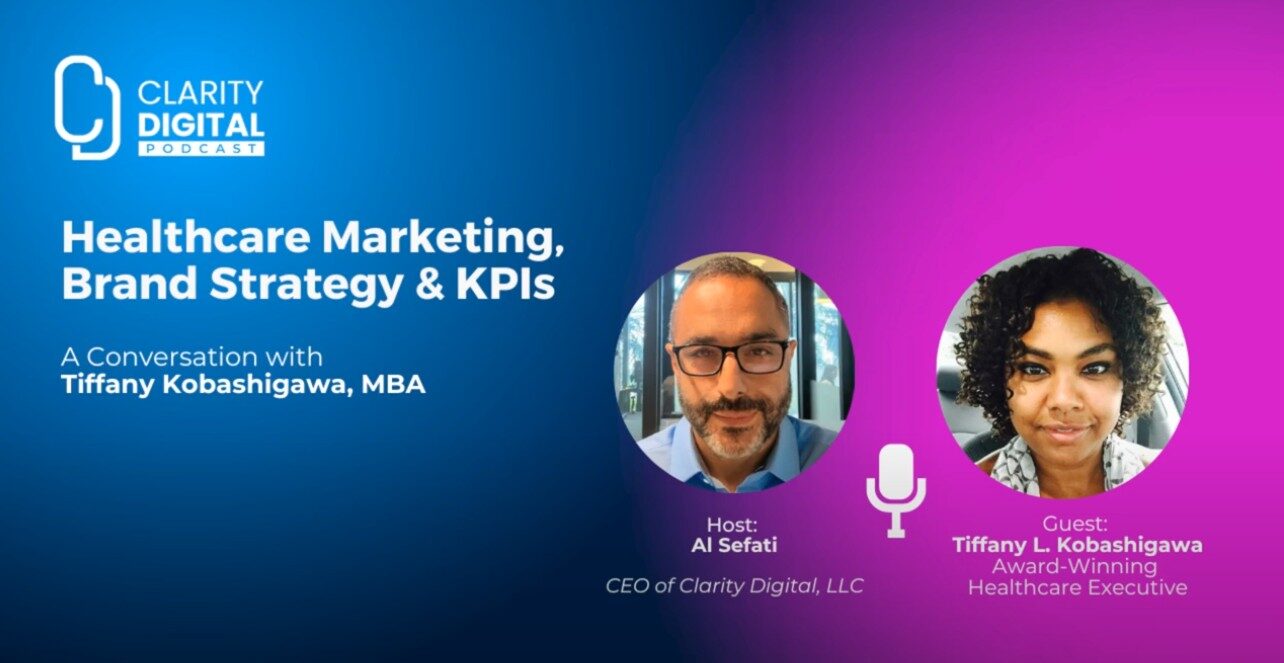In this episode of Clarity Digital Pod, I sat down with Tiffany Kobashigawa, a seasoned healthcare marketing executive with over 20 years of experience, to uncover what’s really happening in healthcare marketing—and why it’s time for the industry to start taking it seriously.
While other industries pour resources into brand building and marketing strategy, healthcare has historically treated marketing like an afterthought. But that’s changing. In this conversation, Tiffany breaks down why branding matters more than ever in healthcare, which KPIs leaders should actually be tracking, and how marketing leaders can earn their seat at the executive table.
Why Healthcare Still Undervalues Marketing
Let’s be honest—healthcare has always been slower to adopt modern marketing practices compared to retail or tech. Many hospital systems and providers are still stuck in a reactive model, only thinking about marketing when patient numbers dip or a new service launches.
Tiffany points out that this mindset is one of the industry’s biggest blind spots. Healthcare is an essential service, and patients are more informed and selective than ever. Yet many organizations continue to underinvest in brand and digital strategy, treating marketing as a cost center rather than a growth engine.
And it shows.
In an era where consumers can compare hospitals the same way they compare hotels or restaurants, patient experience and perception directly impact revenue. That’s where branding and marketing strategy come into play—not just as creative functions, but as business-critical tools.
Branding in Healthcare: Building Trust, Not Just Logos
One of the biggest misconceptions in healthcare is that branding starts and ends with a logo. Tiffany quickly shuts that down. She explains that in healthcare, branding is about building trust and creating consistent, quality experiences across every patient touchpoint—from the website to the waiting room.
We talked about Kaiser Permanente’s Thrive campaign as a great example. It didn’t just refresh a logo or tagline—it shifted how people viewed the brand, focusing on wellness and proactive care. That’s the kind of brand power most healthcare organizations overlook, and it’s costing them.
Patients today are looking for more than a provider. They’re looking for a brand they trust. And trust is built through strategic, consistent branding that reinforces a healthcare organization’s values and mission—day in and day out.
What KPIs Actually Matter in Healthcare Marketing?
Here’s the challenge for many marketing leaders in healthcare: they’re often asked to prove ROI, but the metrics that matter to finance and operations rarely reflect marketing’s full impact.
Tiffany breaks down the key performance indicators that healthcare marketers should focus on:
- Patient acquisition cost – How much are you spending to bring in a new patient? Are you optimizing your channels?
- Conversion rates – Are your digital campaigns leading to actual appointments?
- Brand engagement – Are people interacting with your content, messaging, and brand?
- Retention and loyalty – Are patients coming back, or are they going elsewhere after one visit?
- Revenue contribution – How is marketing influencing bottom-line growth?
These KPIs are more than just numbers. They tell the story of how effectively marketing is driving business results. But to make them count, marketers need to build strong partnerships with finance and operations—so they’re speaking the same language when it’s time to justify budget or resources.
Sales and Marketing Alignment in Healthcare
Unlike in tech or SaaS, where marketing and sales teams are often tightly integrated, healthcare tends to operate in silos. Tiffany highlights that this disconnect creates major inefficiencies and missed revenue opportunities.
She outlines three key areas where marketing and sales need better alignment:
- Shared goals and metrics – Marketing and sales teams need to be accountable to the same outcomes, like patient acquisition or service line growth.
- Internal buy-in – Marketing leaders need support from physicians, executives, and finance teams to make lasting change.
- Communication – Marketers must clearly articulate how their work supports revenue, improves patient experience, and drives growth.
This kind of alignment doesn’t happen overnight. It requires intentional strategy and consistent communication—but it’s the only way to elevate marketing from “support” to strategic leadership.
The Toughest Challenges Facing Healthcare Marketing Today
When asked about the top obstacles marketing leaders face in healthcare, Tiffany didn’t hesitate. There are real structural and cultural barriers holding the industry back, including:
- Limited budgets – Even when patient acquisition is expensive, many healthcare systems still underfund marketing departments.
- Regulatory constraints – HIPAA and privacy laws make it harder to track and personalize marketing efforts.
- Outdated systems – Legacy technology and fragmented patient data prevent real digital transformation.
- Lack of internal alignment – Marketing often operates in isolation, disconnected from operations and clinical workflows.
These aren’t small problems—but they’re not insurmountable. With data-driven strategy, clear communication, and a strong brand foundation, healthcare marketers can start overcoming these challenges and driving real organizational change.
What’s Next for Healthcare Marketing?
Tiffany is optimistic about the future—but she’s clear that success will go to the organizations that adapt now. As we look ahead, several trends are reshaping the landscape:
- Personalized patient experiences – Using data to create more relevant, timely communications that improve outcomes.
- Omnichannel engagement – Meeting patients where they are, whether that’s on search engines, social media, or digital ads.
- First-party data – As cookies fade out, healthcare marketers need better ways to collect and activate their own data.
- Customer experience (CX) as brand – In the future, your brand is the patient experience. Every interaction counts.
Marketing leaders who embrace these trends—and align them with business objectives—will help healthcare organizations thrive, not just survive.
Final Thoughts: Healthcare Marketing is About Driving Growth
Healthcare marketing isn’t just about awareness campaigns or patient portals. It’s about driving growth, improving care, and building long-term trust with patients.
In this episode, Tiffany Kobashigawa makes one thing clear: healthcare marketing deserves a seat at the table. And when marketing, sales, and finance work together, the results speak for themselves.
If you’re a healthcare executive, marketer, or business leader looking to drive real impact, it’s time to rethink your marketing strategy. Because the organizations that prioritize branding, performance metrics, and alignment across departments? They’re the ones that will lead the future of healthcare.




